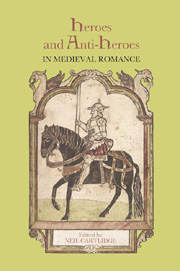Introduction
Published online by Cambridge University Press: 05 February 2013
Summary
Medieval romances so insistently celebrate the triumphs of heroes and the discomfiture of villains that they discourage recognition of just how morally ambiguous, antisocial or even downright sinister their protagonists can be, and, correspondingly, of just how admirable or impressive their defeated opponents often are. This tension between the heroic and the anti-heroic in romance-texts contributes considerably to the complexity of the reading experience that they generate, but it is not an aspect of the genre that has been much discussed up to now. Part of the reason for this lies in the way that medieval romances still tend to be characterized as ideologically and psychologically naïve texts. Romance, so the argument goes, is a genre that typically prefers simplistic scales of value, intellectual commonplaces and easy stereotypes; and it relentlessly depicts the victories and happy endings of its chivalric protagonists only as a means of asserting the intrinsic superiority of the social and ethical ideals that they embody. Viewed in this way, it would perhaps be the very last literary genre in which anyone would expect to find either depth or complexity of characterization, let alone any figures interesting enough to be described as ‘anti-heroes’. Medieval romances may not aspire to the illusion of three-dimensional characters whose motives and emotions are complete enough to seem entirely realistic, but this certainly does not mean that they are incapable of sustaining any ambivalence towards their heroes, or towards the idea of heroism.
- Type
- Chapter
- Information
- Heroes and Anti-Heroes in Medieval Romance , pp. 1 - 6Publisher: Boydell & BrewerPrint publication year: 2012

